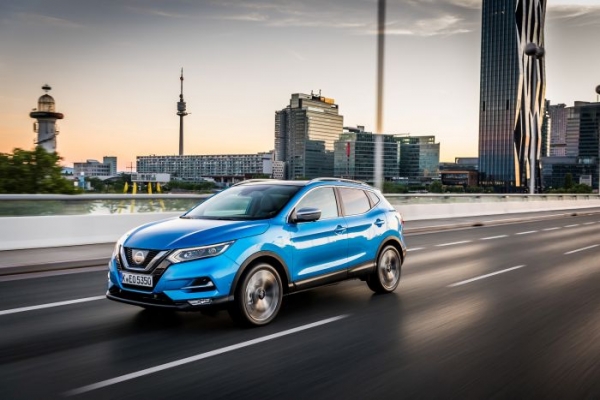
29.5.2019. The Nissan Qashqai is now even safer on the road: The to receives the prices from 21.350 euros available Crossover pioneer drives with advanced comfort and safety equipment, including the ProPILOT driver assistance system for semi-automated Driving in the highest equipment levels, even in series. At the same time, Nissan equipped the range-topping Qashqai Tekna+ independent design accents.
With already the all-electric Nissan Leaf is well-known assistance systems, the Qashqai reduces the Stress in everyday commuter traffic. The middle equipment line, the N-Connecta optional (extra charge 900 euros), from the Tekna even standard ProPILOT includes an intelligent jam assistant Stop&Go function: He brakes the car autonomously to a stop. Driving traffic participants put themselves ahead again in motion, driving the own vehicle again.
The adaptive cruise control system keeps meanwhile, the distance from the vehicle in front, while the lane keeping assist keeps the Qashqai, if needed, with a targeted steering input in the middle of the track. In conjunction with the Nissan Safety Shield, an emergency braking system with motion detection, a fatigue detection system and a blind spot assist are on Board as well. The intelligent Parking assistant are able to maneuver the compact model in addition, in any suitable Parking space.
With the exception of the smart traffic jam assistant, which is reserved exclusively for models with the seven-speed dual-clutch transmission (7DCT) or with Xtronic automatic, include all of these driver assistance systems in the Topausstatt always to the series-production scope.
The Qashqai Tekna is to prices starting from 30.670 Euro in conjunction with the 103 kW/140-HP 1.3-Liter turbo gasoline engine available for the Qashqai Tekna+ start at 34.770 Euro. The Top model benefits from the Dynamic package, which provides the vehicle with unique design accents: The bumpers, front and rear, for example, painted in body color, the side mirrors carry the same silver as the new sidebar. In the interior, a black roof lining and aluminum-wait-look.
As an Alternative to the entry-level petrol engine, which develops, on request, 117 kW/160 PS, for the Qashqai, as before, a 1.5-litre dCi diesel engine with 85 kW/115 HP, which will also be offered with a six-speed manual transmission and the 7DCT, as well as the 110 kW/150 HP 1.7-litre Diesel are available. In conjunction with all-wheel drive and the Xtronic automatic mode takes care of the big compression-ignition engine, optionally, the power transmission gear.


Nissan Qashqai (starting in MY 2018) (photo: Nissan)
Nissan Qashqai 1.3 DIG-T 140 HP: total combined fuel consumption (l/100km): 5,7; CO2-emission combined (g/km): 130; efficiency class B (values according to the method of measurement UN/ECE 101 and VO(EC)715/2007).
Nissan Qashqai 1.3 DIG-T 160 PS: total combined fuel consumption (l/100km): 5,8-5,7; CO2-emission combined (g/km): 131 – 130; efficiency class B (values according to the method of measurement UN/ECE 101 and VO(EC)715/2007).
Nissan Qashqai 1.5 dCi: total combined fuel consumption (l/100km): 4.2 CO2 emissions combined (g/km): 112 – 110; efficiency class: A+ (values according to the method of measurement UN/ECE 101 and VO(EC)715/2007).
Nissan Qashqai 1.7 dCi: total combined fuel consumption (l/100km): 5,8 – 4,8; CO2 emission combined (g/km): 154 – 127; efficiency class: B – A (values according to the method of measurement UN/ECE 101 and VO(EC)715/2007).
The specified values were determined in accordance with the stipulated measuring method in accordance with VO(EC) 715/2007 in the currently applicable version 2017/1347 (WLTP).
Since 1. September 2017 to be certain a new car according to the worldwide harmonized test procedures for Passenger and light commercial vehicles (Worldwide Harmonized Light Vehicles Test Procedure, WLTP), a more realistic test method for the measurement of the fuel consumption and CO2 emissions type-approved. From 1. September of 2018, will replace the WLTP is the new European driving cycle (NEDC). Due to the more realistic conditions of the test, the WLTP measured fuel consumption and CO2 emission values are in many cases higher than the NEDC measured. Currently, the NEDC to communicate values mandatory yet. If it is a new car, which are type-approved in WLTP, are derived from the NEDC-values of the WLTP-values. The additional indication of the WLTP-values can be made up to their mandatory use is voluntary.